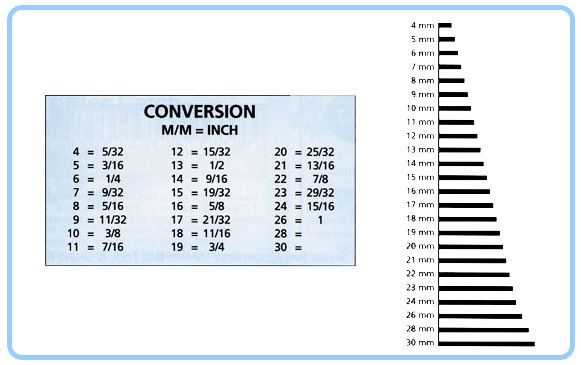42 Millimeter to Inches: The Easy Guide

Welcome to this comprehensive guide on converting the measurement of 42 millimeters to inches, a common task in various industries and everyday life. This conversion is essential for ensuring precision and accuracy when dealing with dimensions, whether you're working in manufacturing, design, or simply need to understand product specifications.
Understanding the Basics: Millimeters and Inches

Millimeters and inches are both units of length used in different measurement systems. Millimeters, abbreviated as mm, are a part of the metric system, widely used globally. In contrast, inches, represented by “, are primarily used in the Imperial and US Customary systems, predominantly in the United States and the United Kingdom.
The conversion between these units is straightforward but crucial, especially when dealing with international standards and specifications.
The Conversion Process: 42 mm to Inches

Converting 42 millimeters to inches is a simple mathematical operation. The conversion factor is 1 inch is equal to 25.4 millimeters. This means that to convert any length in millimeters to inches, you divide the length by 25.4.
For our specific case, the conversion is as follows:
| Length in Millimeters | Length in Inches |
|---|---|
| 42 mm | 1.6535433 inches |

Therefore, 42 millimeters is approximately equal to 1.65 inches.
The Significance of This Conversion
This conversion has practical applications in various fields. For instance, in the electronics industry, many components are manufactured to precise millimeter specifications. When these components are integrated into products designed for the US market, the conversion to inches becomes essential for accurate assembly and fitting.
Similarly, in the world of fashion and jewelry, where millimeters are often used to describe the size of gems or the width of a watch strap, converting to inches provides a more familiar and accessible measurement for customers.
Accuracy and Precision in Conversion
It’s important to note that while this conversion is straightforward, maintaining accuracy is crucial. Even a small discrepancy in measurement can have significant consequences, especially in industries where precision is paramount.
For instance, in the automotive industry, a slight error in converting dimensions from millimeters to inches could result in ill-fitting parts or compromised safety standards.
Tools for Accurate Conversion
To ensure accuracy, various tools and methods are available. Online conversion calculators are readily accessible and provide quick and precise conversions. Additionally, for more complex or frequent conversions, dedicated conversion software or even spreadsheet formulas can be utilized.
Common Misconceptions and Challenges
One common misconception is that the conversion factor is a simple ratio of 1:25.4. While this is the basic conversion rate, it’s important to remember that this is an approximation. In reality, the conversion factor is a decimal number, 0.0393700787, which results from dividing 1 by 25.4.
Another challenge is dealing with fractions. When converting millimeters to inches, the result is often a decimal number. For instance, the conversion of 42 mm to inches results in 1.6535433 inches. In practical applications, this decimal number might need to be rounded off to a specific number of decimal places, depending on the required level of precision.
Real-World Applications

The conversion from 42 millimeters to inches has a wide range of real-world applications. Here are a few examples:
- Photography and Printing: In the world of photography and printing, millimeter specifications are common for camera sensors and paper sizes. Converting these measurements to inches provides a more familiar reference for many photographers and designers.
- Engineering and Construction: Engineers and construction professionals often work with detailed drawings and specifications. Converting dimensions between millimeters and inches ensures that international projects can be accurately executed.
- Product Design and Manufacturing: Many products, especially those with global markets, are designed with specifications in both millimeters and inches. This conversion is crucial for ensuring that the final product meets the intended dimensions.
Future Trends and Implications
As the world becomes increasingly interconnected, the need for accurate conversions between different measurement systems will only grow. The trend towards standardization and global collaboration will further emphasize the importance of precise conversions like 42 millimeters to inches.
With the advancement of technology, we can expect more sophisticated conversion tools and methods. Artificial intelligence and machine learning algorithms could potentially automate these conversions, further reducing the risk of human error.
Conclusion
The conversion from 42 millimeters to inches is a fundamental task with wide-ranging implications. By understanding the process and its significance, we can ensure accurate conversions and facilitate seamless collaboration across different industries and regions.
Whether you're a professional in manufacturing, a designer, or simply curious about the world of measurements, this guide provides a comprehensive understanding of the conversion process and its practical applications.
How accurate are online conversion calculators for millimeters to inches?
+Online conversion calculators are generally very accurate and can provide precise conversions. However, it’s important to ensure that the calculator is reputable and up-to-date. Always double-check critical conversions with multiple sources or dedicated conversion software to ensure accuracy.
Are there any industries where inches are preferred over millimeters, and vice versa?
+Yes, certain industries have a preference for one measurement system over another. For instance, the US construction industry predominantly uses inches, while many European countries prefer the metric system and millimeters. It’s important to understand the standard practices in your industry to ensure accurate conversions.
What are the potential consequences of inaccurate conversions from millimeters to inches?
+Inaccurate conversions can lead to various issues, including ill-fitting parts, compromised safety standards, and design flaws. In extreme cases, it could even result in product recalls or legal implications. Maintaining accuracy in conversions is therefore crucial.



